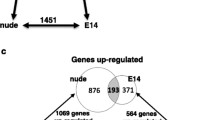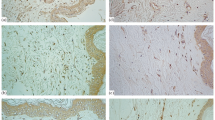Abstract
An increase in the nuchal translucency that can be detected at 10–14 weeks of gestation by ultrasound forms the basis for a screening test for chromosomal abnormality. Several mechanisms leading to this increase in skin thickness have been proposed, including changes of the extracellular matrix, cardiac defects and abnormalities of the large vessels. This study examines the composition of the extracellular matrix of the skin in gestational age-matched fetuses with trisomy 21, 18 and 13 from 12–18 weeks. Immunohistochemistry was applied with monoclonal and polyclonal antibodies against collagen type I, III, IV, V and VI and against laminin and fibronectin. Collagen type VI gene expression was further studied by in situ hybridization to detect differences in expression patterns of COL6A1, COL6A3 and COL1A1 between normal fetuses and those with trisomy 21. The ultrastructure of tissue samples was studied by transmission electron microscopy (TEM) and additionally by immunogold TEM. Further, we examined the morphology of the skin in an animal model for Down’s syndrome, the murine trisomy 16, by light and TEM. The dermis of trisomy 21 fetuses was richer in collagen type VI than that of normal fetuses and other trisomies, and COL6A1, located on chromosome 21, was expressed in a wider area than COL6A3, which is located on chromosome 2. Collagen type I was less abundant in the skin of trisomy 18 fetuses, while the skin of all three trisomies contained a dense network of collagen type III and V in comparison with normal fetuses. Collagen type IV, of which two genes are located on chromosome 13, was expressed in the basement membranes of the skin in all fetuses and additionally in the dermal fibroblasts only of trisomy 13 fetuses. Likewise, laminin was present in all basement membranes of normal and trisomic fetuses as well as in dermal fibroblasts of fetuses with trisomy 18. LAMA1 and LAMA3 genes are located on chromosome 18. Dermal cysts were found in the skin of trisomy 18 and 13, but not in trisomy 21 and normal fetuses. Ultrastructural findings showed that an extracellular precipitate containing glycosaminoglycans was regularly present in the skin of trisomy 21 fetuses and murine trisomy 16 embryos. In conclusion, this study suggests that the skin edema in fetal trisomies is characterized by specific alterations of the extracellular matrix that may be attributed to gene dosage effects as a result of a genetic imbalance due to the condition of fetal trisomy.
Similar content being viewed by others
Author information
Authors and Affiliations
Additional information
Accepted: 20 August 1997
Rights and permissions
About this article
Cite this article
von Kaisenberg, C., Krenn, V., Ludwig, M. et al. Morphological classification of nuchal skin in human fetuses with trisomy 21, 18, and 13 at 12—18 weeks and in a trisomy 16 mouse. Anat Embryol 197, 105–124 (1998). https://doi.org/10.1007/s004290050123
Issue Date:
DOI: https://doi.org/10.1007/s004290050123




